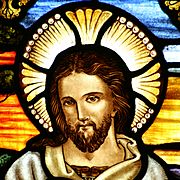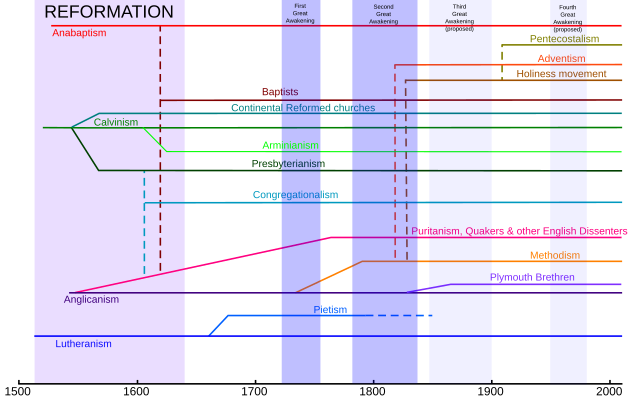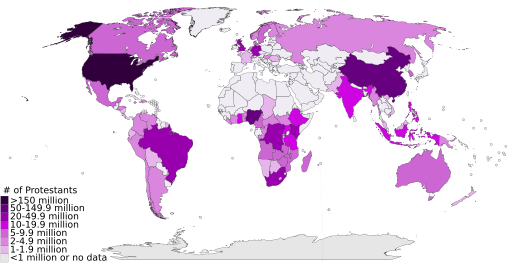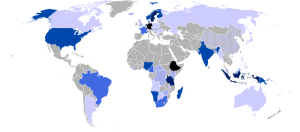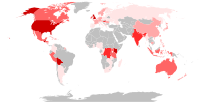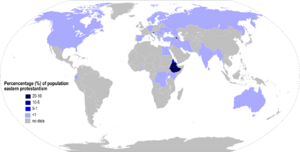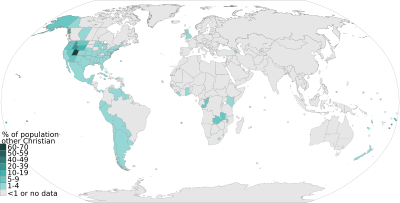List of Christian denominations by number of members facts for kids
Percent of Christian population that is: Catholic (50.1%) Protestant (36.7%) Eastern Orthodox (9.4%) Oriental Orthodox (2.5%) Other Christian (1.3%)
This is a list of Christian denominations by number of members. It is inevitably partial and generally based on claims by the denominations themselves. The numbers should therefore be considered approximate and the article is an ongoing work-in-progress.
The list includes the following Christian denominations: the Catholic Church including Eastern Catholic Churches as well as independent Catholic denominations, Protestant denominations with at least 200,000 members (including Anglican churches, which are sometimes described as a via media between Catholicism and Protestantism), the Eastern Orthodox Church (and its offshots), Oriental Orthodox Churches (and their offshoots) and all the other Christian branches with distinct theologies, such as Restorationist, Nontrinitarian and Nestorian denominations.
Christianity is the largest religious group in the world, with an estimated 2.3 to 2.6 billion adherents in 2020.
Contents
- Christian denominational families
- Christianity – 2.3 to 2.6 billion
- Catholicism – 1.345 billion
- Protestantism – 800 million–1 billion
- Eastern Orthodoxy – 220 million
- Oriental Orthodoxy – 62 million
- Non-trinitarian Restorationism – 35 million
- Nestorianism – 0.6 million
- See also
Christian denominational families
The various denominations of Christianity fall into several large families, shaped both by culture and history.
Christianity arose in the first century AD after Rome had conquered much of the western parts of the fragmented Hellenistic empire created by Alexander the Great. The linguistic and cultural divisions of the first century AD Roman Empire with, broadly speaking, a Latin West and a Greek East, but also with significant areas in North Africa where Coptic was the dominant language, and areas in the Near East where Syriac or Aramaic was the dominant language, were reflected in the early Christian church. The church was called "catholic" meaning "universal" from very early in the second century, a tacit acknowledgement of the many different cultures it encompassed.
The early Christian Church suffered great, although intermittent, persecution from the state until Emperor Constantine the Great issued the Edict of Milan in 313 AD, legalizing Christianity. Shortly after the cessation of persecution, as the Church, for the first time had the luxury of reflecting on the meaning of its own teachings, significant disputes arose, particularly over the nature of Christ, and the relationship between Christ, the Father, and the Spirit. The Church chose to address those disputes with Ecumenical councils, the first four of which were at Nicaea, Constantinople, Ephesus and Chalcedon. The first two of these councils, the First Council of Nicaea and the First Council of Constantinople gave birth to the Nicene Creed which has become the touchstone for Christian beliefs.
Both of the next two Councils, the Council of Ephesus, and the Council of Chalcedon led to significant ruptures in the Church. Many Christians espousing the minority position at these two councils, even after extensive discussion and attempts at reconciliation, chose to strike out on their own, rather than to accept the positions held by the majority of the church fathers at the councils. Refusing to accept the Council of Ephesus, the Church of the East, encompassing many Syriac speaking Christians in what was then the far East of the Empire, split off in 431 AD. A few decades later, in 451 AD, after the Council of Chalcedon, the group that later became known as the Oriental Orthodox Churches, encompassing many Coptic speaking Christians in North Africa, also split off.
In 1054 AD, an accumulation of misunderstanding, disrespect and genuine theological differences led to the Great Schism, dividing Greek speaking Christians who became the Eastern Orthodox, from Latin speaking Christians who kept the name Catholic, but increasingly prefaced it with the adjective "Roman."
Beginning in 1517, the remaining western, Latin speaking church was itself rent asunder by the Protestant Reformation with many Christians rejecting papal authority and gathering together in new ways. Broadly speaking Protestantism has four streams: Lutheranism, Calvinism, Anabaptism, and Anglicanism. While all of these Christian groups from the Church of the East on, have their own subsequent splits, the fragmentation in Protestantism has been extreme, with tens of thousands of denominations. Some of these fragmented groups, particularly among the Eastern churches, have sought to return to Rome, and have reunited themselves under papal authority.

Christianity – 2.3 to 2.6 billion
Catholicism – 1.345 billion
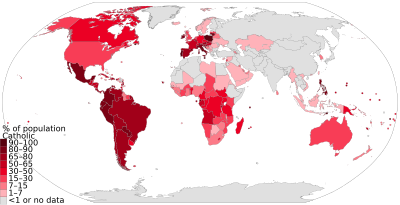
Catholicism is the largest branch of Christianity with 1.345 billion, and the Catholic Church is the largest among churches. Figures below are in accordance with the Annuario Pontificio, at 2019. The total figure does not include independent denominations that self-identify as Catholic, numbering some 18 million adherents.
Eastern Catholic Churches – 18 million
- Byzantine Rite – 8.7 million
- Ukrainian Greek Catholic Church – 5.5 million
- Melkite Greek Catholic Church – 1.6 million
- Romanian Greek Catholic Church – 0.5 million
- Ruthenian Greek Catholic Church – 0.4 million
- Hungarian Greek Catholic Church – 0.3 million
- Slovak Greek Catholic Church – 0.3 million
- Belarusian Greek Catholic Church – 0.1 million
- Italo-Albanian Catholic Church – 0.01 million
- Greek Catholic Church of Croatia and Serbia – 0.01 million
- Georgian Byzantine Catholic Church (not sui iuris) – 0.01 million
- Albanian Greek Catholic Church – 0.01 million
- Russian Greek Catholic Church – 0.01 million
- Greek Byzantine Catholic Church – 0.006 million
- Macedonian Greek Catholic Church – 0.001 million
- Bulgarian Greek Catholic Church – 0.001 million
- East Syriac Rite – 4.9 million
- Syro-Malabar Catholic Church – 4.3 million
- Chaldean Catholic Church – 0.6 million
- West Syriac Rite – 4.2 million
- Maronite Church – 3.5 million
- Syro-Malankara Catholic Church – 0.5 million
- Syriac Catholic Church – 0.2 million
- Armenian Rite – 0.8 million
- Armenian Catholic Church – 0.8 million
- Alexandrian Rite – 0.5 million
- Coptic Catholic Church – 0.2 million
- Eritrean Catholic Church – 0.2 million
- Ethiopian Catholic Church – 0.07 million
Canonically irregular groups
- Society of Saint Pius X – 1 million
Sedevacantists
- Congregation of Mary Immaculate Queen
- Society of Saint Pius V
Independent Catholicism – 18 million
Various denominations that self-identify as Catholic, despite not being affiliated with the Catholic Church.
- Philippine Independent Church – 6 million (in communion with the Anglican Communion)
- Catholic Patriotic Association – 5 million
- Apostolic Catholic Church – 5 million
- Traditionalist Mexican-American Catholic Church – 2 million
- Brazilian Catholic Apostolic Church – 0.56 million
- Old Catholic Church – 0.1 million (in communion with the Anglican Communion)
- Polish National Catholic Church – 0.03 million
- Palmarian Christian Church – 0.002 million
Protestantism – 800 million–1 billion
Protestantism is the second largest major group of Christians by number of followers. Estimates vary from 800 million to 1 billion, or between 31% and 38% of all Christians. The main reason for this wide range is the lack of a common agreement among scholars as to which denominations constitute Protestantism. For instance, most sources but not all include Anabaptism, Anglicanism, Baptists and Independent Nondenominational Christianity as part of Protestantism. Moreover, Protestant denominations altogether do not form a single structure comparable to the Catholic Church, or to a lesser extent the Eastern Orthodox communion. However, several different comparable communions exist within Protestantism, such as the World Evangelical Alliance, Anglican Communion, World Communion of Reformed Churches, World Baptist Alliance, World Methodist Council and the World Lutheran Federation. Regardless, 900 million is the most accepted figure among various authors and scholars, and thus is used in this article. Note that this 900 million figure also includes Anglicanism, as well as Anabaptists, Baptists and multiple other groups that might sometimes disavow a common "Protestant" designation, and would rather prefer to be called, simply, "Christian".
Historical Protestantism – 300–500 million
The number of individuals who are members of historical Protestant Churches totals to 300–500 million.
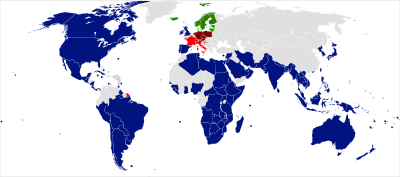
Anglicanism – 110 million
There are about 110 million Christians in Anglican tradition, mostly part of the Anglican Communion, the third-largest Christian communion in the world, with 42 members (provinces).
- Anglican Communion – 85 million
- Church of England – 25.0 million
- Church of Nigeria – 20.1 million
- Church of Uganda – 8.1 million
- Anglican Church of Kenya – 5.0 million
- Church of South India – 3.8 million
- Province of the Episcopal Church of South Sudan – 3.5 million
- Anglican Church of Australia – 3.1 million
- Anglican Church of Southern Africa – 3 million
- Anglican Church of Tanzania – 2.0 million
- Episcopal Church in the United States – 1.6 million
- Church of North India – 1.5 million
- Province of the Episcopal Church of Sudan – 1.1 million
- Anglican Church of Rwanda – 1.0 million
- Church of the Province of Central Africa – 0.9 million
- Anglican Church of Burundi – 0.8 million
- Church in the Province of the West Indies – 0.8 million
- Anglican Church in Aotearoa, New Zealand and Polynesia – 0.6 million
- Church of the Province of the Indian Ocean – 0.5 million
- Church of Christ in the Congo–Anglican Community of Congo – 0.5 million
- Church of Pakistan – 0.5 million
- Province of the Anglican Church of the Congo – 0.5 million
- Anglican Church of Mozambique and Angola – 0.5 million
- Anglican Church of Canada – 0.4 million
- Church of the Province of West Africa – 0.3 million
- Church of Ireland – 0.3 million
- Anglican Church of Papua New Guinea – 0.2 million
- Anglican Church of Melanesia – 0.2 million
- Episcopal Church in the Philippines - 0.1 million
- Anglican Episcopal Church of Brazil - 0.1 million
- Anglican Church of Mexico - 0.1 million
- Church of the Province of South East Asia - 0.1 million
- Anglican Church of Korea - 0.1 million
- Spanish Reformed Episcopal Church - 0.005 million
- Lusitanian Catholic Apostolic Evangelical Church - 0.005 million
- Continuing Anglican movement and independent churches – 0.7 million
- Traditional Anglican Church – 0.4 million
- Anglican Church in North America – 0.1 million
- Reformed Evangelical Anglican Church of South Africa – 0.1 million
Baptist churches – 100 million
The worldwide Baptist community numbers about 100 million. However, the Baptist World Alliance, the world communion of Baptist churches, self-reports only 51 million baptized believers, as Baptists do not count children as members, since they believe in believer's baptism. Therefore, the BWA is the 9th largest Christian communion.
- Southern Baptist Convention – 13.2 million
- National Baptist Convention, USA, Inc. – 8.4 million
- Nigerian Baptist Convention – 6.5 million
- National Missionary Baptist Convention of America – 3.1 million
- National Baptist Convention of America International, Inc. – 3.1 million
- Baptist Union of Uganda – 2.5 million
- Baptist Community of Congo – 2.1 million
- Baptist Convention of Tanzania – 2.0 million
- Brazilian Baptist Convention – 1.8 million
- Baptist General Convention of Texas – 1.7 million
- Progressive National Baptist Convention – 1.5 million
- Council of Baptist Churches in Northeast India – 1.3 million
- American Baptist Churches USA – 1.2 million
- Baptist Bible Fellowship International – 1.2 million
- Lott Carey Foreign Mission Convention – 1.1 million
- Baptist Community of the Congo River – 1.1 million
- National Primitive Baptist Convention of the U.S.A. – 1.0 million
- Myanmar Baptist Convention – 1.0 million
- Cooperative Baptist Fellowship – 0.8 million
- Baptist General Association of Virginia – 0.6 million
- Baptist Convention of Kenya – 0.6 million
- Nagaland Baptist Church Council – 0.6 million
- Korea Baptist Convention – 0.5 million
- Samavesam of Telugu Baptist Churches – 0.5 million
- Orissa Evangelical Baptist Crusade – 0.5 million
- National Baptist Convention (Brazil) – 0.4 million
- Baptist Convention of Malawi – 0.3 million
- Garo Baptist Convention – 0.3 million
- Convention of Philippine Baptist Churches – 0.3
- Ghana Baptist Convention – 0.3
- Union of Baptist Churches in Rwanda – 0.3 million
- Venture Church Network – 0.2 million
- National Association of Free Will Baptists – 0.2 million
- Convention of Visayas and Mindanao of Southern Baptist Churches – 0.2 million
- Manipur Baptist Convention – 0.2 million
- Evangelical Baptist Church of the Central African Republic – 0.2 million
- Converge – 0.2 million
- Seventh Day Baptists – 0.05 million
Lutheranism – 70–90 million
The number of adherents in the Lutheran denominations totals to 70–90 million persons (the Lutheran World Federation reports 77 million and is the sixth largest communion) being represented in the following churches:
- Protestant Church in Germany – 10.8 million, with the remainder of the Protestant Church in Germany's 19.2 million members being non-Lutheran
- Ethiopian Evangelical Church Mekane Yesus – 10.4 million
- Evangelical Lutheran Church in Tanzania – 7.9 million
- Church of Sweden – 5.6 million
- United Evangelical Lutheran Churches in India – 4.5 million
- Church of Denmark – 4.3 million
- Batak Christian Protestant Church – 4.1 million
- Malagasy Lutheran Church – 4.0 million
- Evangelical Lutheran Church of Finland – 3.8 million
- Church of Norway – 3.7 million
- Evangelical Lutheran Church in America – 2.9 million
- Lutheran Church of Christ in Nigeria – 2.2 million
- Lutheran Church – Missouri Synod – 1.8 million
- Evangelical Lutheran Church of Papua New Guinea – 1.8 million
- Evangelical Lutheran Church in Namibia – 0.9 million
- Evangelical Lutheran Church in Southern Africa – 0.6 million
- Evangelical Church of the Lutheran Confession in Brazil – 0.6 million
- The Protestant Christian Church – 0.5 million
- Evangelical Lutheran Church in the Republic of Namibia – 0.4 million
- Evangelical Free Church of America – 0.4 million
- The Indonesian Christian Church – 0.3 million
- Lutheran Congregations in Mission for Christ – 0.3 million
- Evangelical Lutheran Church of Cameroon – 0.3 million
- Protestant Church of the Augsburg Confession in Austria – 0.3 million
- Evangelical Lutheran Church in Zimbabwe – 0.3 million
- Evangelical Lutheran Church of Latvia – 0.3 million
- Christian Protestant Church in Indonesia – 0.3 million
- Wisconsin Evangelical Lutheran Synod – 0.3 million
- Church of Iceland – 0.2 million
- Simalungun Protestant Christian Church – 0.2 million
- Evangelical Lutheran Church of Brazil – 0.2 million
- Protestant Church of the Augsburg Confession of Alsace and Lorraine – 0.2 million
- Evangelical Church of the Augsburg Confession in Slovakia – 0.2 million
- Evangelical-Lutheran Church in Hungary – 0.2 million
- Estonian Evangelical Lutheran Church – 0.2 million
- Laestadianism (various denominations) – 0.2 million
Calvinism / Reformed churches – 70–80 million
The Reformed tradition is represented by 70-80 million people who hold membership in the following churches; the World Communion of Reformed Churches is the fourth-largest communion.
- Presbyterianism – 40 million
- Presbyterian Church of East Africa – 4.0 million
- Presbyterian Church of Nigeria – 3.8 million
- Presbyterian Church of Africa – 3.4 million
- National Presbyterian Church in Mexico – 2.8 million
- Church of Central Africa Presbyterian – 2.5 million
- Church of Christ in Congo–Presbyterian Community of Congo – 2.5 million
- Presbyterian Church of Korea (TongHap) – 2.4 million
- Presbyterian Church in Korea (HapDong) – 2.4 million
- Presbyterian Church in Cameroon – 2.0 million
- Presbyterian Church of Cameroon – 1.8 million
- Presbyterian Church of India – 1.5 million
- Presbyterian Church in Korea (BaekSeok) – 1.5 million
- Presbyterian Church (USA) – 1.1 million
- Presbyterian Church in Sudan – 1.0 million
- Presbyterian Church of Ghana - 1.0 million
- Presbyterian Church of Brazil – 0.7 million
- Evangelical Presbyterian Church, Ghana – 0.6 million
- United Church of Christ in the Philippines – 0.5 million
- Uniting Presbyterian Church in Southern Africa – 0.5 million
- United Church of Canada – 0.4 million
- Presbyterian Church in America – 0.4 million
- Presbyterian Church of Pakistan – 0.4 million
- Kosin Presbyterian Church in Korea – 0.4 million
- Church of Scotland – 0.3 million or 1.5 million
- Korean Presbyterian Church – 0.3 million
- Presbyterian Church in Rwanda – 0.3 million
- Uniting Church in Australia – 0.2 million
- Presbyterian Church in Taiwan – 0.2 million
- Presbyterian Church in Ireland – 0.2 million
- Continental Reformed Protestantism – 30 million
- Church of Jesus Christ in Madagascar – 6 million
- Protestant Church in Indonesia – 3.1 million
- United Church in Zambia – 3.0 million
- Evangelical Church of Cameroon – 2.5 million
- Christian Evangelical Church in Timor – 2.0 million
- Swiss Reformed Church – 1.9 million
- Protestant Church in the Netherlands – 1.5 million
- Reformed Church in Hungary – 1.15 million
- Dutch Reformed Church in South Africa (NGK) – 1.1 million
- Christian Evangelical Church in Minahasa – 0.7 million
- United Church in Papua New Guinea and the Solomon Islands – 0.6 million
- Protestant Church in Western Indonesia – 0.6 million
- Evangelical Christian Church in Tanah Papua – 0.6 million
- Protestant Church of Maluku – 0.6 million
- Uniting Reformed Church in Southern Africa – 0.5 million
- Reformed Church in Romania – 0.5 million
- Toraja Church – 0.4 million
- Reformed Church of France – 0.4 million
- Lesotho Evangelical Church – 0.3 million
- Evangelical Christian Church in Halmahera – 0.3 million
- Christian Church of Sumba – 0.3 million
- Karo Batak Protestant Church – 0.3 million
- Christian Reformed Church of Nigeria – 0.3 million
- Reformed Church in Zambia – 0.3 million
- Evangelical Reformed Church in Angola – 0.2 million
- Christian Reformed Church in North America – 0.2 million
- Kalimantan Evangelical Church – 0.2 million
- Javanese Christian Church – 0.2 million
- Indonesian Christian Church Synod – 0.2 million
- Church of Christ in the Sudan Among the Tiv – 0.2 million
- Evangelical Church of Congo – 0.2 million
- Christian Evangelical Church of Sangihe Talaud – 0.2 million
- Central Sulawesi Christian Church – 0.2 million
- Evangelical Reformed Church in Bavaria and Northwestern Germany – 0.2 million
- Congregationalism – 5 million
- Evangelical Congregational Church in Angola – 0.9 million
- United Church of Christ – 0.7 million
- United Congregational Church of Southern Africa – 0.5 million
Methodism – 60–80 million
The Methodist movement is represented by 60–80 million people (a figure including adherents but non-members), found in denominations including the following; the World Methodist Council (WMC) is the fifth largest communion. Not all of the following churches are member churches of the WMC. The largest Methodist denomination, the United Methodist Church, is suffering a large split by the Global Methodist Church, thus figures for the two denominations are an ongoing process.
- United Methodist Church – 12 million
- African Methodist Episcopal Church – 2.5 million
- Church of the Nazarene – 2.65 million
- Methodist Church Nigeria – 2 million
- The Salvation Army – 1.8 million
- Methodist Church of Southern Africa – 1.7 million
- African Methodist Episcopal Zion Church – 1.4 million
- Korean Methodist Church – 1.3 million
- Free Methodist Church – 0.9 million
- Christian Methodist Episcopal Church – 0.9 million
- Methodist Church Ghana – 0.8 million
- Methodist Church in India – 0.6 million
- Methodist Church in Kenya – 0.5 million
- Korean Evangelical Church of America, Korean Holiness Evangelical Church – 0.5 million
- Global Methodist Church – 0.4 million
- Wesleyan Church – 0.4 million
- Methodist Church in Brazil – 0.2 million
- Methodist Church of Fiji and Rotuma – 0.2 million
Adventism – 22.7 million
- Seventh-day Adventist Church – 22.3 million
- Church of God (Seventh-Day) – 0.2 million
- Advent Christian Church - 0.1 million
- Seventh Day Adventist Reform Movement - 0.042 million
Restorationism – 4.1 million
- Churches of Christ – 2 million
- Christian churches and churches of Christ – 1.1 million
- Community of Disciples of Christ in Congo – 0.7 million
- Christian Church (Disciples of Christ) – 0.3 million
Anabaptism – 4 million
- Mennonites – 2.1 million
- Schwarzenau Brethren (German Baptists) – 1.5 million
- Amish – 0.3 million
- Hutterites – 0.05 million
Hussites – 1.2 million
- Moravian Church – 1.1 million
- Czechoslovak Hussite Church – 0.099 million
- Unity of the Brethren Baptists – 0.035 million
Plymouth Brethren – 1 million
The Plymouth Brethren number around 1 million members.
Modern Protestantism – 400–500 million
The denominations listed below did not emerge from the Protestant Reformation of the 16th century or its commonly acknowledged offshoots. Instead, they are broadly linked to Pentecostalism or similar other independent evangelical and revivalistic movements that originated in the beginning of the 20th century. For this reason, several sources tend to differentiate them from Protestants and classify them together as Independents, Non-core Protestants etc. Also included in this category are the numerous, yet very similar Nondenominational churches. Nonetheless, sources eventually combine their numbers to the Protestant tally. Despite the absence of centralized control or leadership, if considered as a single cohort, this will easily be the second largest Christian tradition after Roman Catholicism. According to the Center for the Study of Global Christianity (CSGC), there are an estimated 450 million Independents world-wide, as of mid-2019.
Pentecostalism – 280 million
Those who are members of the Pentecostal denomination number around 280 million people.
- Assemblies of God – 67 million (the 7th largest communion)
- Apostolic Church – 15 million
- International Circle of Faith – 11 million
- Fangcheng Fellowship – 10 million
- China Gospel Fellowship - 10 million
- International Church of the Foursquare Gospel - 9 million
- Ethiopian Kale Heywet Church - 9 million
- Church of God in Christ - 6.5 million
- Church of God (Cleveland, Tennessee) - 6 million
- Ethiopian Full Gospel Believers' Church - 4.5 million
- The Church of Pentecost – 4.2 million
- International Pentecostal Holiness Church – 4 million
- Indonesian Bethel Church – 3 million
- Christian Congregation of Brazil – 2.8 million
- The Pentecostal Mission – 2.5 million
- True Jesus Church – 2.5 million
- Universal Church of the Kingdom of God – 2 million
- Church of God of Prophecy – 1.5 million
- Heal Our Land – 1.5 million
- Pentecostal Church in Indonesia - 1.5 million
- Apostolic Faith Mission of South Africa – 1.2 million
- Association of Pentecostal Churches of Rwanda – 1 million
- Jesus Is Lord Church Worldwide – 1 million
- God is Love Pentecostal Church – 0.8 million
- Maranatha Christian Church – 0.75 million
- Pentecostal Church of God - 0.5 million
- Indian Pentecostal Church of God – 0.5 million
- Association of Vineyard Churches – 0.3 million
- Worldwide Church of God's Power – 0.3 million
Nondenominational Christianity – 80–100 million
- Calvary Chapel – 25 million
- Christian and Missionary Alliance – 6 million
- Born Again Movement – 3 million
- Church of God (Anderson, Indiana) – 1.2 million
African initiated churches – 60 million
60 million people are members of African initiated churches.
- Zion Christian Church – 15 million
- Eternal Sacred Order of Cherubim and Seraphim – 10 million
- Kimbanguist Church – 5.5 million
- Redeemed Christian Church of God – 5 million
- Church of the Lord (Aladura) – 3.6 million
- Council of African Instituted Churches – 3 million
- Church of Christ Light of the Holy Spirit – 1.4 million
- African Church of the Holy Spirit – 0.7 million
- African Israel Church Nineveh – 0.5 million
New Apostolic Church – 10 million
The New Apostolic Church has around 10 million members.
Messianic Judaism – 0.3 million
Messianic Judaism has a membership of 0.3 million people.
Eastern Protestant Christianity – 22 million
Eastern Protestant Christianity (or Eastern Reformed Christianity) encompasses a range of heterogeneous Protestant Christian denominations that developed outside of the Occident, from the latter half of the nineteenth century and yet keeps elements of Eastern Christianity, to varying degrees. Most of these denominations came into being when existing Protestant Churches adopted reformational variants of Eastern Orthodox liturgy and worship; while others are the result of reformations of Eastern Orthodox beliefs and practices, inspired by the teachings of Western Protestant missionaries. Some Protestant Eastern Churches are in communion with similar Western Protestant Churches. However, Protestant Eastern Christianity within itself, does not constitute a single communion. This is due to the diverse polities, practices, liturgies and orientations of the denominations which fall under this category.
- Ethiopian-Eritrean Evangelical Church – 16.5 million, Alexandrian Rite
- Believers Eastern Church – 3.5 million, West Syrian Rite
- Mar Thoma Syrian Church – 1 million, Syro-Antiochene Rite (in communion with the Anglican Communion)
- Armenian Evangelical Church – 0.25 million, Armenian Rite
- St. Thomas Evangelical Church of India - 0.1 million, Syro-Antiochene Rite
- Evangelical Church of the Augsburg Confession in Slovenia - 0.02 million, Byzantine Rite
- Evangelical Church of Romania – 0.16 million, Byzantine Rite
- Kosovo Protestant Evangelical Church – 0.15 million, Byzantine Rite
Eastern Orthodoxy – 220 million
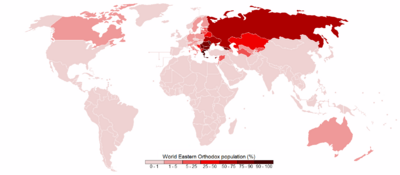
The best estimate of the number of Eastern Orthodox Christians is 220 million or 80% of all Orthodox Christians worldwide. Its main body consists of the various autocephalous churches along with the autonomous and other churches canonically linked to them, for the most part form a single communion, making the Eastern Orthodox Church the second largest single denomination behind the Catholic Church. In addition, there are several Eastern Orthodox splinter groups and non-universally recognized churches.
Autocephalous churches – 168 million
- Russian Orthodox Church – 100 million
- Romanian Orthodox Church – 17–18.8 million
- Church of Greece – 10 million
- Serbian Orthodox Church – 8-12 million
- Bulgarian Orthodox Church – 8-10 million
- Ecumenical Patriarchate of Constantinople – 5.25 million
- Greek Orthodox Patriarchate of Antioch – 4.3 million
- Georgian Orthodox Church – 3.5 million
- Macedonian Orthodox Church – 2 million
- Church of Cyprus – 0.7 million
- Polish Orthodox Church – 0.6 million
- Greek Orthodox Patriarchate of Alexandria – 0.5 million
- Albanian Orthodox Church – 0.4 million
- Greek Orthodox Patriarchate of Jerusalem – 0.4 million
- Orthodox Church of the Czech Lands and Slovakia – 0.075 million
Autonomous churches – 5 million
- Metropolitan Church of Chișinău and All Moldova (Moscow Patriarchate) – 3.2 million
- Russian Orthodox Church Outside of Russia – 0.4 million
- Metropolitan Church of Bessarabia (Moldova) (Romanian Patriarchate) – 0.72 million
- Estonian Orthodox Church of the Moscow Patriarchate – 0.3 million
- Orthodox Church of Finland (Ecumenical Patriarchate) – 0.06 million
- Chinese Orthodox Church (Moscow Patriarchate) – 0.03 million
- Orthodox Church in Japan (Moscow Patriarchate) – 0.03 million
- Estonian Orthodox Church (Ecumenical Patriarchate) – 0.02 million
Churches in communion with the above Orthodox Churches but with disputed autocephaly or spiritual independence – 14-21 million
- Orthodox Church of Ukraine – 12–18 million (recognized as Orthodox by four churches, not recognized as Orthodox by all others)
- Ukrainian Orthodox Church (Moscow Patriarchate) – 2 million (recognized as Orthodox by the majority churches; but as a self-governing church under the Moscow Patriarchate; not as a spiritually independent church within the communion except one orthodox church)
- Orthodox Church in America – 0.09 million (recognized as Orthodox by nearly all churches, except one church)
- Latvian Orthodox Church – 0.02 million (recognized as self-governing orthodox church under the Moscow Patriarchate by all churches; but its autocephaly is disputed)
Non-universally recognized churches – 4 million
- Belarusian Autocephalous Orthodox Church – 2.4 million
- Orthodox Church of Greece (Holy Synod in Resistance) – 0.75 million
- Old Calendar Bulgarian Orthodox Church – 0.45 million
- Orthodox Church in Italy – 0.12 million
- Old Calendar Orthodox Church of Romania – 0.05 million
- Montenegrin Orthodox Church – 0.05 million
Other separated Orthodox groups – 6 million
- Old Believers – 5.5 million
- Greek Old Calendarists – 0.86 million
- True Orthodox church – 0.85 million
- Evangelical Orthodox Church – 0.07 million
- Autocephalous Turkish Orthodox Patriarchate – 0.002
Oriental Orthodoxy – 62 million

The Oriental Orthodox Churches are those descended from those that rejected the Council of Chalcedon in 451. Despite the similar name, they are therefore a different branch of Christianity from the Eastern Orthodox (see above). There are an estimated 62 million Oriental Orthodox Christians, worldwide.
Autocephalous churches – 61.7 million
- Ethiopian Orthodox Tewahedo Church – 37 million
- Coptic Orthodox Church – 10 million
- Armenian Apostolic Church – 9 million
- Mother See of Holy Etchmiadzin – 6 million
- Holy See of Cilicia – 1.5 million
- Armenian Patriarchate of Constantinople – 0.5–0.7 million
- Armenian Patriarchate of Jerusalem – 0.34 million
- Eritrean Orthodox Tewahedo Church - 2 million
- Malankara Orthodox Syrian Church - 2 million
- Syriac Orthodox Church – 1.4 million
- Jacobite Syrian Christian Church – 1.2 million
Autonomous churches – 0.01 million
- French Coptic Orthodox Church – 0.01 million
Churches not in communion – 0.07 million
- Malabar Independent Syrian Church – 0.06 million
- British Orthodox Church – 0.01 million
- Albanian-Udi Church (registered as an official church in Azerbaijan) – 0.006 million
Non-trinitarian Restorationism – 35 million
A sixth group is composed by Nontrinitarian Restorationists. These groups are quite distinct from orthodox Trinitarian restorationist groups such as the Disciples of Christ, despite some shared history.
Latter Day Saint movement or Mormonism – 17 million
- The Church of Jesus Christ of Latter-day Saints – 17 million
- Community of Christ – 0.25 million
Oneness Pentecostalism – 7.5 million
- United Pentecostal Church International – 5.5 million
- Pentecostal Assemblies of the World – 2 million
Minor denominations – 4.4 million
- Iglesia ni Cristo – 3 million
- Unification Church (aka Moonies) – 1–2 million
- La Luz del Mundo – 1–5 million (see La Luz del Mundo#Membership statistics)
- Unitarian Universalism – 0.6 million
- Unitarian Universalist Association – 0.2 million
Note: Unitarian Universalism developed out of Christian traditions but no longer identifies as a Christian denomination.
- Unitarian Universalist Association – 0.2 million
- Church of Christ, Scientist – 0.4 million
- Church of Christ, 4th Watch – 0.6 million
- World Mission Society Church of God – 0.1 million
- Friends of Man – 0.07 million
- Christadelphians - 0.05 million
- The Family International – 0.01 million
Nestorianism – 0.6 million
Divisions occurred within the Church of the East, especially the schism of 1552, but by 1830 two unified patriarchates and distinct churches remained: the Assyrian Church of the East and the Chaldean Catholic Church (now an Eastern Catholic Church in communion with the Holy See).
- Assyrian Church of the East – 0.5 million
- Chaldean Syrian Church – 0.01 million
- Ancient Church of the East – 0.1 million
See also
- Christian state
- List of Christian denominations
- List of current Christian leaders
- List of largest church buildings
- List of schisms in Christianity
- List of the largest Protestant denominations
- Major religious groups



